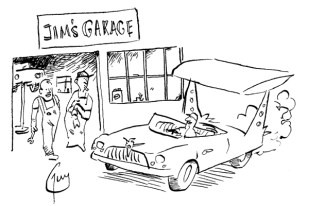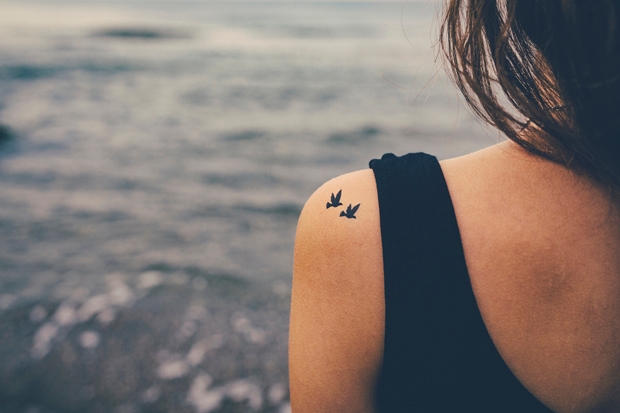Brooklyn

Shall I have my sister’s skin peeled off for display after she dies? Specifically, the tattooed bits — the swatches on either forearm adorned with foliate designs by her favourite artist, and the patch on her wrist inked in her own handwriting with transliterated Hebrew. I’ve always liked them, and not just because they annoy Mother. Should they be separated from her mortal remains, preserved through the wonders of mortuary science, and mounted in a shadow box to grace my bookshelf in her memory? I ran the idea by her the other day while lounging in her Brooklyn garden. Without looking up from the barbecue where she was grilling our formerly free-range dinner, Sister replied, ‘What?’ Her reaction was understandable. She is fashionable, not morbid. She is also in her thirties, in rude good health, and — one has every reason to hope — many decades from death. Even so, I’ve been beset with the question of what to do with her tattooed skin in the unhappy event that she kicks the bucket before me ever since learning that it was possible to do anything with it at all. And why not? Roughly 30 per cent of Americans and 25 per cent of Europeans have at least one tattoo. They are not all regrettable and many were expensively rendered, so it’s only canny that morticians should cater to their remains. ‘It’s like Johnny Depp said, your tattoos tell your story!’ I press on. The Hollywood actor years ago declared his intention to exhibit his inked hide after he dies. Sister is unimpressed and says Depp is ‘disgusting’. On the tattoo-preservation thing, ‘No. It’s too bizarre.’ It’s not, though. Embalmers have been preserving tattoos for centuries, with or without the consent of the tattooed. The Wellcome Collection holds more than 300 sections of inked skin, which it purchased in 1929 from a French osteopath. Some were cut from the corpses of soldiers, criminals; most are of unknown provenance. That sort of thing is frowned upon nowadays, though there’s more tattooed flesh than ever to go around. Bodily bereavement merchandise is certainly nothing new. Queen Victoria wore Prince Albert’s hair in a locket around her neck for years after his death, setting off a trend in elaborate mourning accessories woven from dead men’s locks. Bereavement bling has been enjoying a revival, thanks to engineering advances which let mourners have cremated remains compressed into diamonds and crystals. And now there is something for the tatted set, and the people who love them. Indeed we have a couple of options, I tell Sister, who is pretending to ignore me. The Netherlands-based Foundation for the Art and Science of Tattooing opened in 2013 to offer post-mortem tattoo plastination, starting at €300 for ten square centimetres of skin. ‘We basically turn it into silicone,’ said co-founder Peter van der Helm, when I inquired about the process, ‘and for 300 years at least, the tattoo will stay looking exactly the same.’ On the phone from Amsterdam, the tattoo and graffiti artist was quick to clarify: ‘I don’t do it myself — I’m not a mortician. I’m not really into dead people. But we have a very professional team of pathologists.’ The foundation has fulfilled ten orders so far, according to van der Helm, with another ‘60 or 70 in the database’, by which he means that 60-odd still-living tattooed people have paid their fees, registered sections of their skins to be preserved, and signed all the necessary paperwork. His clients range from the terminally hip — ‘people who are really highly tattooed’, the Johnny Depp types — to the terminally ill. ‘The first person we did,’ van der Helm recalled, ‘was a woman from the US. She was very sick — she knew she was going to die. She gave her tattoos to her kids, it was really great.’ The service is available only by advance directive, meaning Sister would have to fill out the forms ahead of time to bequeath me her tattoos. ‘That’s not going to happen,’ she says, even after I feed her van der Helm’s line that ‘tattooing is a temporary art form, but it shouldn’t be’. There’s also a more classic embalming procedure available through Save My Ink Forever LLC, which opened outside Cleveland last year. The company contracts through funeral homes and crematoriums as an ‘at need’ service — the kind of add-on that next-of-kin may opt for along with customised urns and interactive headstones. Advance directives are not necessary, though they are helpful to prevent the sort of bickering that accompanies more traditional posthumous disposition. ‘Sometimes we see families fighting over who gets what tattoo — multiple people will want the same tattoo!’ says Kyle Sherwood, the third-generation embalmer who runs Save My Ink Forever with this father. Having spent years perfecting his proprietary tattoo-preservation method, Sherwood adds, ‘It’s gratifying to know we’re offering something that means that much to a family.’ Prices for the Ohio-based service vary at the discretion of the contracting undertaker. Here in New York, the Colonial Funeral Home of Staten Island started offering the Save My Ink Forever package this year, charging $1,595 for the first ‘recovery’ and $795 for each one after that. ‘It hasn’t mainstreamed yet,’ said Michael Lanza, funeral director at the Colonial. ‘We’ve only done one or two. But I would imagine that as the technology goes forward and the cost comes down, it may appeal to more people.’ As it is, ‘I see so many funerals where people spend thousands of dollars on flower arrangements that they’re only going to throw away.’ When he puts it that way, a tidily preserved keepsake tattoo seems downright sensible. Back in Brooklyn, Sister is wavering. ‘I guess you can do what you want,’ she says, extinguishing the barbecue and plating our dinner. ‘I won’t care, I’ll be dead.’ That is roughly how US jurisdictions would see it. To guarantee that her tattoos don’t wind up framed on my bookshelf or hung in a museum, she would have to expressly forbid it in a notarised will, and hire an executor to keep an eye on things after she’s gone. Not being a sociopath, I assure her that won’t be necessary. ‘Maybe I’ll go with the Victorian hair-jewellery thing,’ I muse as we tuck into dinner. ‘Or the cremation crystals. Would that be all right?’ ‘Fine. Can we talk about literally anything else now, please?’






Comments